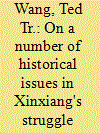|
|
|
Sort Order |
|
|
|
Items / Page
|
|
|
|
|
|
|
| Srl | Item |
| 1 |
ID:
131456


|
|
|
|
|
| Publication |
2014.
|
| Summary/Abstract |
This study focuses on the poetry of the well-known Kurdish poet Cegerxwîn (1903-84). Contextualizing Cegerxwîn's life and literary career within his specific social, political and historical circumstances, this article demonstrates the way in which Kurdish classical poetry during his madrasa education shaped Cegerxwîn's poetic creation. Furthermore, the oppression and exploitation of Kurdish peasants at the hands of tribal chiefs, sheikhs and nation-states contributed to Cegerxwîn's adoption of a Marxist and nationalist social and political standpoint. This article, attempting a closer reading of his poetry, suggests that at the essence of his poetry is found the continued use of the metaphor of awakening. Hence Cegerxwîn's poetics and politics can best be depicted as one of awakening the oppressed and subordinate social groups including the Kurds, peasants and workers from their deep sleep of oppression and exploitation. Through his Kurdish poetics and politics of awakening, it is argued, Cegerxwîn participates in the progressive political discourses of his times.
|
|
|
|
|
|
|
|
|
|
|
|
|
|
|
|
| 2 |
ID:
129264


|
|
|
|
|
| Publication |
2012.
|
| Summary/Abstract |
This is part of a supplementary address by Comrade Jiang Zemin at the Central Committee's Taiwan work meeting. For some time already, ethnic separatists in China's Xinjiang and outside its borders have been rampantly active and have brought serious harm to Xinjiang' stability and development. We must be highly alert and take strict precautions. Our leading cadres and especially high-placed cadres must inform themselves about both the historical and current circumstances of the so-called East Turkistan issue touted by Xinjiang's ethnic separatist forces. The Xinjiang region has since ancient times maintained close contacts with the motherland's Central Plains. From the Han dynasty up to the mid and late Qing dynasty, Xinjiang and its surrounding regions came under the general designation "western regions." In the second Shenjue year of Han Emperor Xuandi, or 60 by the Gregorian calendar, the western regions were officially incorporated into the motherland's territory. During the Sui and Tang dynasties, the central government continued to exercise administration over the western regions, and Tang Emperor Taizong substantially strengthened its jurisdiction over that vast region.
|
|
|
|
|
|
|
|
|
|
|
|
|
|
|
|
| 3 |
ID:
132720


|
|
|
|
|
| Publication |
2014.
|
| Summary/Abstract |
Innovation is fundamental to a space agency's mission. Yet, the industry's current dominant approach to new technology development - concerted investment in step-changes in capabilities to support a particular application - contradicts the conventional wisdom of innovation theory. In order to understand why, this paper uses a unique empirical case study, in which exogenous historical circumstances created unexpected additional opportunities for technology investment, to explore the merits of this approach. The value of follow-on periods of R&D is assessed in terms of simple marginal returns, implications for workforce dynamics and the interaction of mission sequencing and technology strategy. The analysis reveals an important contingency between mission paradigm and the value of follow-on investment. Specifically, while marginal performance improvements can be achieved at lower costs, their value depends on the availability of an appropriate mission opportunity. In the current paradigm, the risk of obsolescence is high compared to the potential benefit. However, if a new small mission, frequent flights, paradigm were to take hold, there may be great value in refocusing R&D strategy on later round improvements.
|
|
|
|
|
|
|
|
|
|
|
|
|
|
|
|
|
|
|
|
|